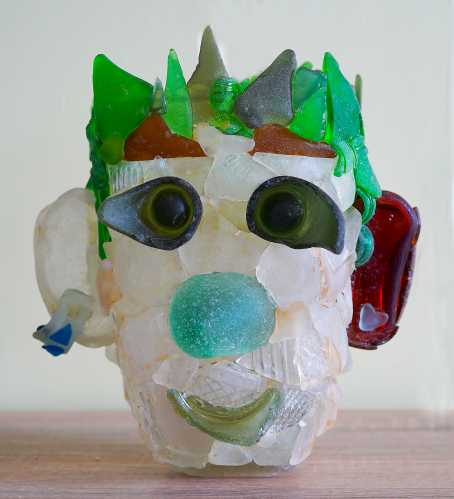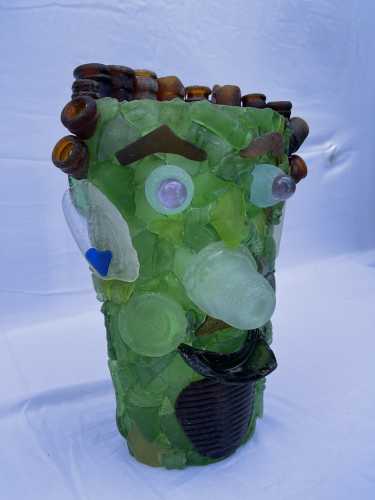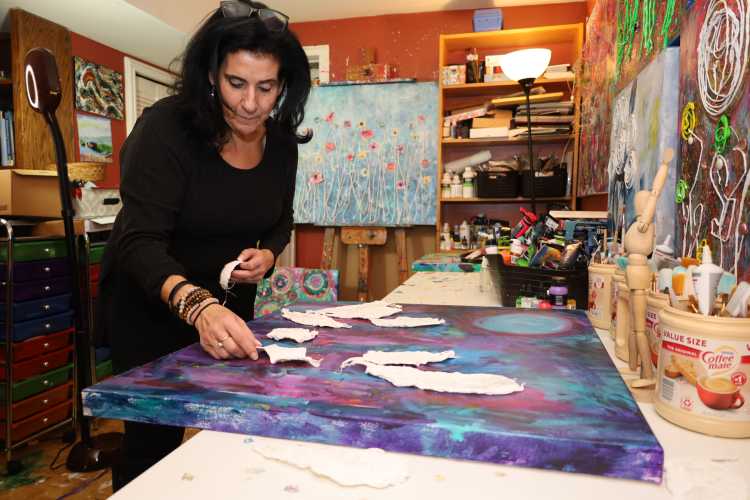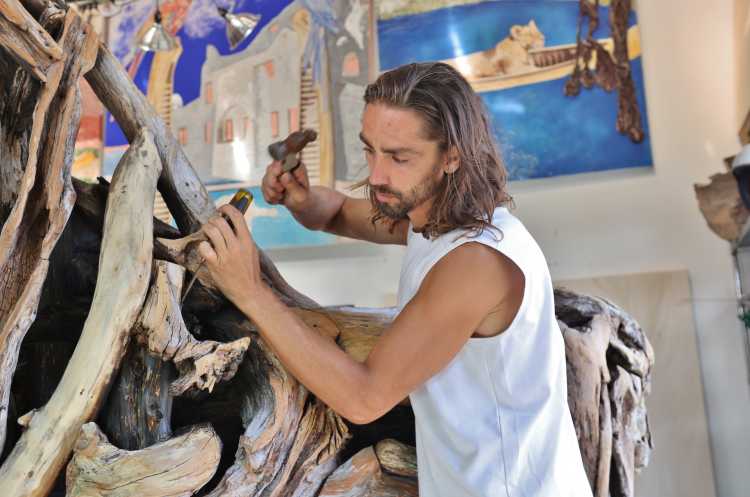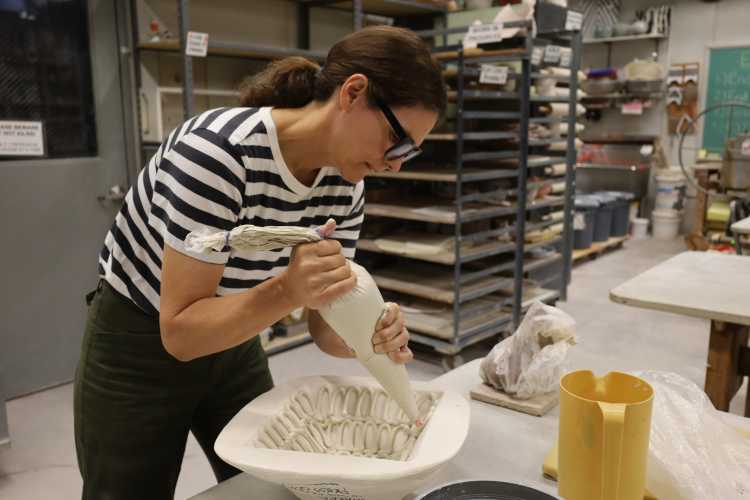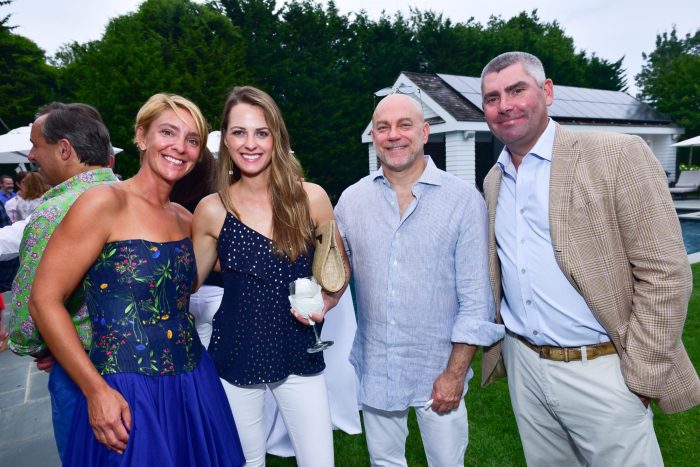If you’ve ever been on Sands Point, you might have noticed a runner with an oversized fanny pack meticulously exploring the shoreline.
The runner spends a lot of time near the water in the upscale North Shore village nestled between Hempstead Harbor, Manhasset Bay and the Long Island Sound. He’s logged enough hours on his favorite stretch of beach to become something of a year-round fixture in the area. Maybe you saw him there on a sultry July afternoon – or on a frigid February morning as an unforgiving wind blew in from the north.
At first glance, he probably looked like just another healthy, late-middle-aged dude getting his miles in for the day. But if you sat back and watched just a little while longer, you would have realized that the runner was also a treasure hunter – and he was hunting for a very specific kind of treasure.
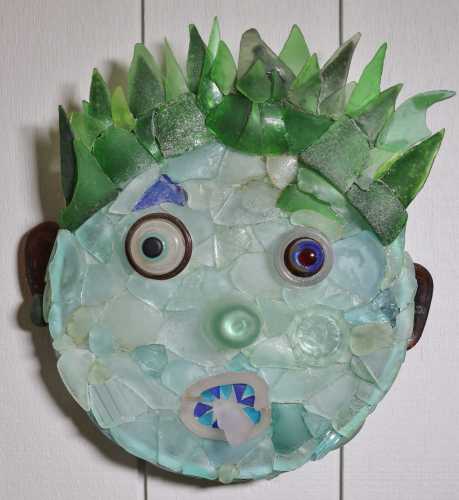
The runner’s name is Avery Fuchs. And for a decade and a half, he has been gathering sea glass and transforming it into art.
Born and raised in Brighton Beach, Brooklyn, Fuchs spent a good chunk of his adult life working in Manhattan, where he lived until the late-1990s, eventually moving with his family to Long Island and discovering the creative potential of sea glass. He and his wife currently split their time between Port Washington and Hampton Bays.
About 15 years ago, Fuchs had the aha moment that turned him into a working artist, when the mothers of several of his son’s friends introduced him to the virtues of what was destined to become his creative milieu. The women told him about all the beautiful sea glass they were finding on the beach. Some of them were even selling the jewelry they were making from it.
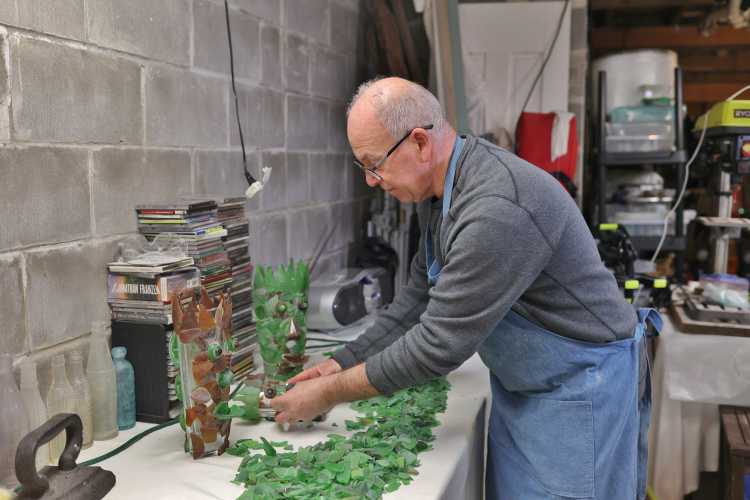
Fuchs started collecting sea glass during his regular runs to the water from his home in Port Washington, and he was increasingly captivated by what he was discovering.
“I was taken by the beauty of their colors, smoothed shapes, infinite variety and mysterious origin,” he writes. Soon, he started bringing home five pounds or more of glass a day.
In the beginning, he would simply immerse his favorite pieces in water or shine a light behind them to see how they would react.
Eventually, he began to place selected pieces of glass in vases. Then he started gluing the glass to the exteriors of the vases or other receptacles.
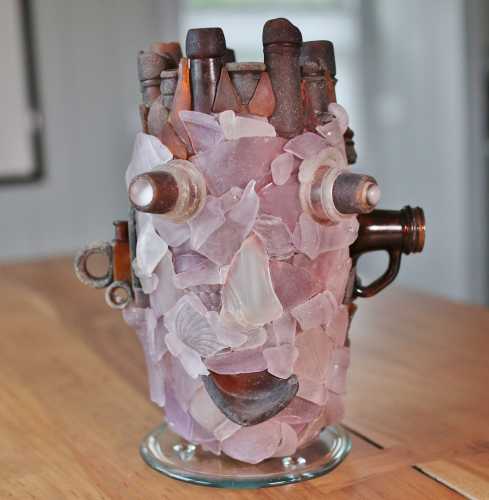
From those humble beginnings, Fuchs’ art has evolved radically. His more recent creations feature complex, evocative figures with stories to tell. His bust work in particular – both standalone and free standing – represents a particularly exciting use of the sculptural form.
Fuchs’ physical process is relatively straightforward. After he collects a day’s worth of glass, he sorts the pieces by shape, color, size and category, then soaks them in water and bleach for a few weeks to remove the residue built up over many years in the sea and sand.
“The vision of the piece starts to develop depending upon what base I find and the direction my imagination leads me,” he writes. “I may start with a vase, an acrylic sheet, a clock, a lamp shade, or whatever I come across… The personalities of the pieces are developed as I go.”
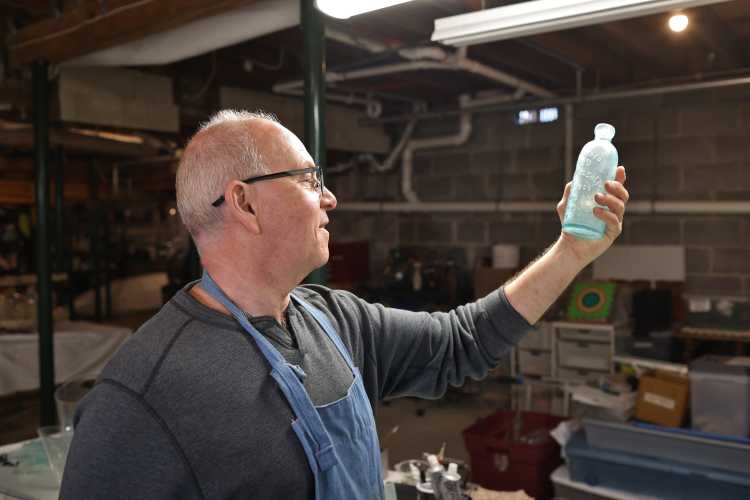
When he selects a particular piece of glass for a project, he fashions it into the size and shape he needs using a wet saw and other grinding, cutting and sanding tools, then glues it into place with a clear adhesive.
Fuchs doesn’t know how each piece of glass he finds made its way to its penultimate resting place. The more romantic notion would be that it rode in on the tide from a passing ship. But Fuchs believes that most of what he finds was originally landbound, having been buried in the sand or dumped into the sea by a local property owner or a member of their household staff – or discarded on the beach by a careless visitor.
And while some of the glass is very difficult to date precisely, Fuchs has read fairly extensively on the topic and often has a general sense of the age of the fragments he uses. And sometimes, he finds an intact bottle or fragment with its actual manufacturing date stamped on it – which is why he knows that certain pieces he uses in his finished work are well over a century old.
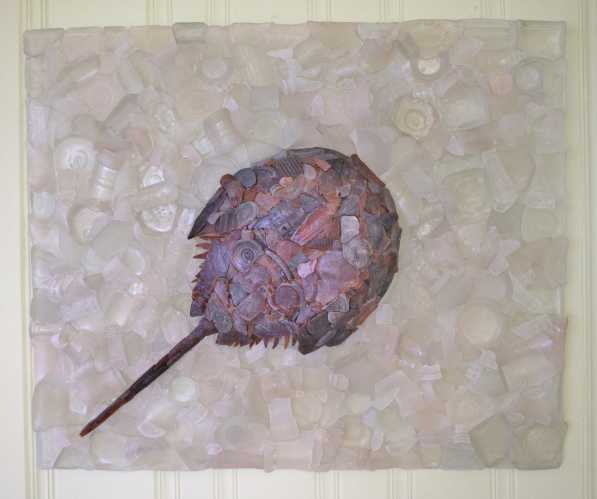
“Some of the pieces I use are from alcohol or medicine bottles that were made in the late 1800s,” he says. “And over time, between erosion and sitting in the salt water, the edges get rounded and the glass takes on a beautiful patina.”
The aesthetics of the glass aside, Fuchs is also intensely interested in what his materials signify.
“Each piece has journeyed from unknown distances and destinations,” he notes. “Every fragment has a mysterious story to tell, had a previous life and purpose and was discarded or went down with the ship. Mother Nature is omnipresent in this art. She has triumphed over time, transforming ordinary garbage into natural jewels.”
Human beings have been arguing about the nature of creativity forever. But most people would agree that sometimes, art is the byproduct of profound sadness – a way to deal with grief and loss.
Fuchs had just begun collecting and sculpting with sea glass when he and his family endured a life-changing experience.
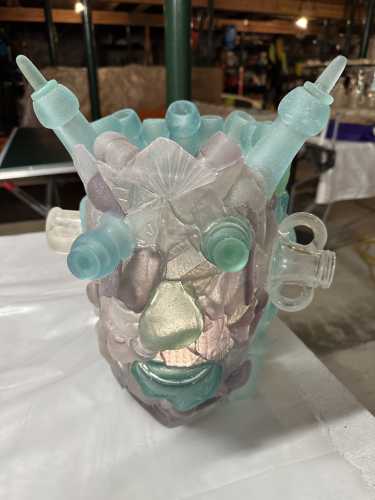
“As my new artistic endeavor started to crawl out of its infancy, I lost my 20-year-old daughter to suicide,” Fuchs writes in his artist’s statement. ”Hayley Rose was a talented, award-winning artist in her own right. My occasional dabbling into this relatively new hobby now became my daily lifeline. Hand over hand, I slowly journeyed out of what was then an endless tunnel. Hayley was with me, her passion and creativity omnipresent along the passage of time and healing. The broken sea glass creations you see on this website truly are symbols of hope, rejuvenation, and resilience.”
Pointing out that May is National Mental Health Awareness Month, Fuchs stresses that he would like his work to not only honor the memory of his daughter, but also to help others who might be suffering.
“Certainly part of what I want to do with my art is create awareness and also to raise money for mental health initiatives,” he says. “People struggle with depression and it’s very important that they seek help when they need it.”
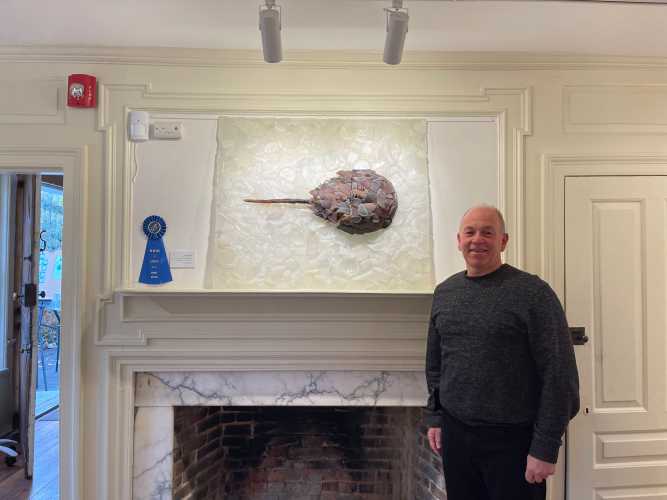
While he created the majority of his art in the years following a devastating loss, Fuchs’ work is in no way somber or hopeless or wracked with pain. In fact, several of his most impactful and compelling pieces are imbued with a sense of whimsy. Yes, the whimsy has a bite to it – and more than a whiff or two of irony – but it certainly doesn’t read as the work of a defeated soul.
For example, Fuchs’ “Wilson” pays homage to the iconic volleyball that doubled as Tom Hanks’ BFF in Cast Away (2000). Constructed mostly of emerald colored glass with funky multi-colored eyes and a protruding tongue, the piece is infinitely more expressive and “human” than the original Wilson on which it is based.
Fuchs’ art is clearly more than a hobby. But at this stage of his life, it’s still less than a full-time vocation. He continues to work full time as a partner in a technology company. His Port Washington and Hampton Bays homes are both fitted with enough tools of the trade to allow him to do his thing in either location. But as retirement gets closer, Fuchs, 68, plans to expand the Hampton Bays studio and devote more time to his craft.
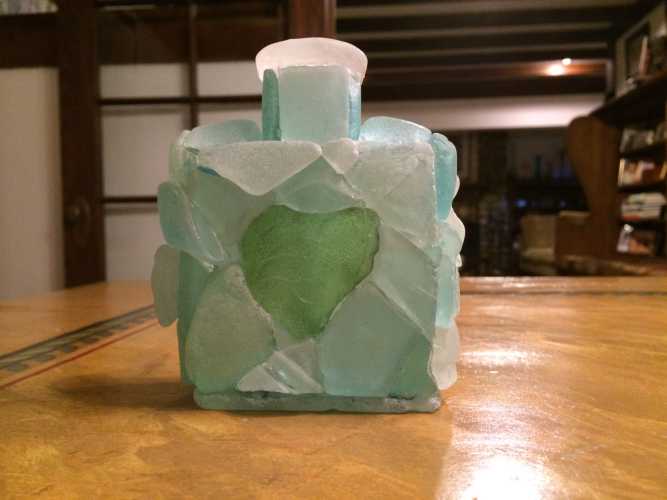
Both of his homes are fitted with enough tools of the trade to allow him to do his thing in either location. But as retirement gets closer, Fuchs, 68, plans to expand the Hampton Bays studio and devote more time to his craft.
“It is truly labor and a labor of love to find, clean, sort and assemble the shards to create a finished sculpture,” he writes. “I feel the individual broken pieces are reincarnated into a whole new soul when I add that last fragment. Each unique artwork is a symbol of resilience, providing reassurance that there is still positive transformation in this world.”
For more on Avery Fuchs’ sea glass sculptures, visit his website.
This article appeared in the Memorial Day weekend issue of Behind The Hedges in Dan’s Papers. Read the full digital edition by tapping here. For previous Master Craftsman columns, click here.
